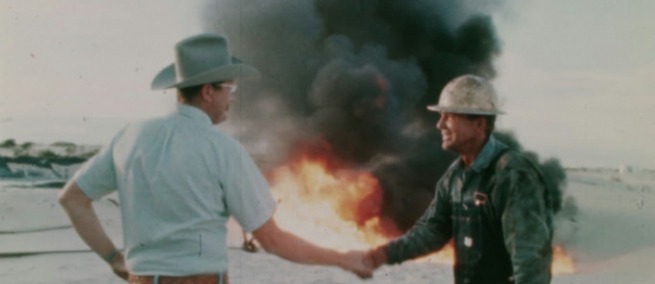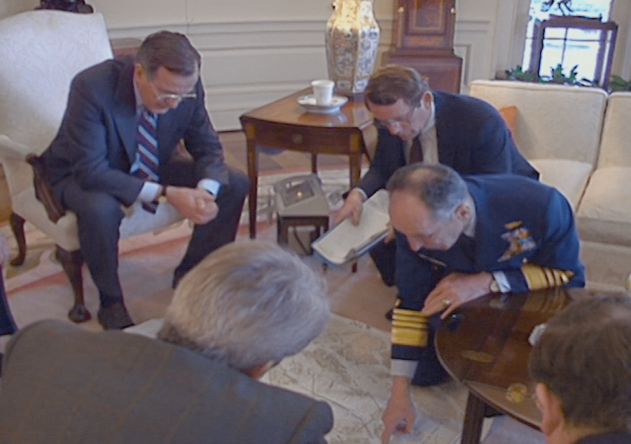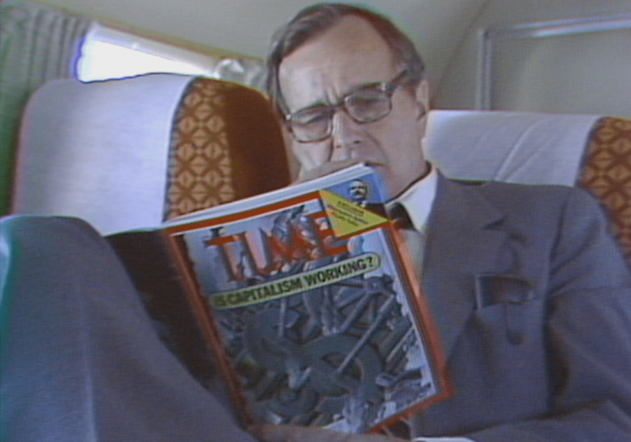
In THE WHITE HOUSE EFFECT, filmmakers Pedro Kos, Bonni Cohen, and Jon Shenk revisit a pivotal moment in American environmental history, tracing the political unraveling of climate consensus during the George H. W. Bush administration. Supported by the Alfred P. Sloan Foundation and now streaming on Netflix, the documentary uses a rich tapestry of archival footage to illuminate how climate science—once embraced across party lines—became a battleground of ideology and industry influence. Kos sat down with Sloan Science & Film to discuss the film’s origins, its distinctive visual style, and the urgent relevance of its message today.
Sloan Science & Film: How did you and your fellow directors come to focus specifically on the H. W. Bush administration?
Pedro Kos: My fellow directors Bonni and Jon have made several films in the climate space, including THE ISLAND PRESIDENT and AN INCONVENIENT SEQUEL: TRUTH TO POWER. They’re always thinking of new ways to humanize and to bring life to this issue that is vital to everyone living on this planet. In 2018, we all separately read a New York Times Magazine article by Nathaniel Rich, which became the book Losing Earth. We were blown away by it because it pulled back the curtain to show how science coalesced in the late 1970s and early 1980s but then became a political football towards the very late 1980s and the early 1990s. We were aware of this, but I personally can say I was deeply unaware of all the intricacies and the human drama that unfolded. We got super excited and started to think about how to bring this story to life. We all agreed we had to do so in a way that really brings home the fact that this was accepted science. This was not controversial, yet it became something of controversy.
We were shocked to see, in the archives from the 1988 election, that both candidates ran as environmentalists. Both candidates promised to tackle the climate crisis. The Republican candidate for president, George H.W. Bush, said in his speech, ‘If you're worried about the greenhouse effect, wait until you see the White House effect. And as president, I intend to do something about it.’ That was a promise that he made and that's where we got the title from.
SS&F: The film makes you feel as though you are flipping through the channels or watching home videos in someone’s living room. How did you arrive at that visual style?
PK: We all admire archival vérité, meaning documentaries which are stitched together from solely archival materials. That was appealing to us because if we were going to turn on our camera to the present, that would automatically carry the political connotation that we currently have, where [climate change] is a binary issue depending on which political party you are affiliated with. We wanted to build a time machine and take the audience back to a time when this was a mom-and-pop issue everyone could get behind.
It took an enormous, daunting archival search. We amassed over 14,000 pieces of archive. First, we were looking for the characters that appeared in the book, but it was hard to translate. We began to see what other materials were available and dug all the way back to the 1800s, as far back as the advent of photography in the 1840s and the drilling of the first commercial oil in Pennsylvania in 1859. Our early cuts went from the 1850s to the present. The 1850s was when the first studies began to emerge that carbon dioxide had a heating property in the atmosphere. A scientist by the name of Eunice Foote put out the first paper that said CO2 heats up the Earth.
We wanted to get it all but in piecing it together, and we saw that the human drama really took place in that '88 to '92 period.

Still from THE WHITE HOUSE EFFECT. Courtesy of Netflix.
SS&F: How so?
PK: That was the period when we went from consensus and unanimity to a divided electorate. That drama was personified within the H.W. Bush administration, by H.W. Bush himself but also by the head of the EPA Bill Reilly and chief of staff John Sununu. That’s how we started to uncover more material, especially at the Bush Presidential Library. That opened up a huge door for us.
SS&F: How big of a team were you working with, given that volume of the footage?
PK: We had three of us acting as editors, plus Bonnie, Jon, and I as directors, and we had three producers. We had a wonderful pair of archival producers. On this, more than other films, it was an extraordinarily collaborative effort where the roles blended and everyone did a bit of everything because it was such a passion project for all of us.

Still from THE WHITE HOUSE EFFECT. Courtesy of Netflix.
SS&F: How you feel the Exxon Valdez oil spill in 1989 changed things between George H.W. Bush's campaign as an environmental candidate and the pivot we see four years later? Do you think it woke oil companies up to their mounting PR crisis?
PK: To begin, I have to say how revelatory I found the studies done by oil companies in the mid 1980s to be – particularly Exxon’s – which echoed the scientific community’s consensus on climate change. They were seeing exactly the same thing. All of those studies are now reality. They were correct. The predictions that they made back then are what we're living through now.
In terms of what we saw in the ‘88 presidential campaign, the oil industry was becoming increasingly concerned by the campaigns of both presidential candidates, especially George H.W. Bush. We found their articles, their editorials, their letters, which expressed their concerns about promises from Bush becoming a reality. The other thing we found to be quite revelatory was how open Bush seemed to be to taking action. What we saw from the Exxon Valdez spill was that the reaction from the oil companies was to circle the wagons. As you said, it hypercharged and expedited their work to counter environmental measures because they had a PR disaster in their hands. They needed to confront that and change the narrative as fast as they could, so they started applying the tobacco industry playbook: deny, counter, and split the electorate.
This was echoed from within the administration by John Sununu, the chief of staff, who had an open door to a lot of the oil company lobbyists and executives who were very much interested in countering the narrative within the administration. You have this big battle going on with the American public, but that's also happening within the administration. There was even a political cartoon that featured Bill Reilly as the angel on one side of Bush's ear and John Sununu as the devil with a pitchfork on the other. It was shocking to see all that play out in such a Shakespearean way.

Still from THE WHITE HOUSE EFFECT. Courtesy of Netflix.
SS&F: Given all of the footage you amassed, was there any scientific data that didn’t make the final cut but you’d like to share with our readers?
PK: There was so much we wanted to get in there but at the end of the day, it's that the scientific facts are now speaking for themselves. What the scientists foresaw in 1988 is becoming a reality, and we are on a real trajectory. This film is about choices, the choices that we make as citizens. Who we vote for has an impact. We’re seeing people angered by the film, and we hope that people can tap into that sentiment and take action because it's up to us.
♦
PARTNERS
TOPICS